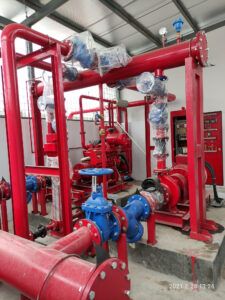The Importance of Fire Safety and How Contractors Implement Hydrant Systems
Ensuring fire safety is essential for the protection of lives and property in both residential and commercial buildings. A well-planned fire safety system, including a hydrant system, is one of the most reliable tools for mitigating fire risks. Below is a detailed look at why fire safety is crucial and how contractors effectively implement fire hydrant systems in projects.
1. Why Fire Safety is Important
- Protection of Lives: The primary goal of any fire safety system is to protect occupants in case of an emergency. Without a proper fire prevention and control system, buildings become hazardous during fire incidents.
- Property Preservation: Fires can cause extensive damage to structures, which can be expensive to repair. Fire safety systems reduce the potential for major damage.
- Legal Compliance: Many countries require strict adherence to fire safety regulations. Failure to meet these standards can result in heavy penalties or legal action.
- Insurance Requirements: Most insurance providers require proof of adequate fire safety measures for coverage, ensuring that the building is properly protected.
2. Key Elements of Fire Safety in Buildings
- Fire Detection Systems: Smoke alarms, heat detectors, and automated fire detection systems provide early warning in the event of a fire.
- Fire Suppression Systems: These include sprinklers, fire extinguishers, and hydrant systems that help to control or extinguish fires.
- Emergency Exits: Clearly marked and accessible emergency exits ensure that occupants can leave the building quickly and safely during a fire.
- Maintenance and Training: Regular inspections and training programs ensure the fire safety system is functioning properly and that people know how to respond in an emergency.
3. How Contractors Implement a Fire Hydrant System
Fire hydrant systems are crucial components of a fire protection system. They provide the firefighters with access to water, allowing them to control and extinguish fires more efficiently. Here’s how contractors implement these systems in construction projects:
a. Planning and Design
- Site Survey: Contractors begin by assessing the site to determine where hydrants should be placed. Key factors include building size, local fire regulations, and proximity to existing water sources.
- Hydraulic Calculations: Ensuring there is enough water pressure to feed the hydrant system during a fire is essential. Contractors calculate the building’s water demand and design the system accordingly.
- Compliance with Codes: Contractors follow national and local fire safety codes to determine the number, size, and placement of hydrants.
b. Installation of Key Components
- Water Supply Network: Contractors connect the hydrant system to the main water supply, ensuring a continuous flow of water. Backup water storage tanks may also be installed if needed.
- Pumps and Valves: Pump systems ensure adequate water pressure during emergencies. Control valves are installed to regulate the flow of water.
- Hydrant Placement: Hydrants are strategically placed both inside and outside the building, allowing firefighters easy access to water during fire suppression activities.
c. Testing and Commissioning
- System Pressure Testing: Before a hydrant system is considered operational, contractors perform pressure tests to ensure the system can handle the required water flow and pressure levels.
- Flow Testing: This ensures that the hydrants will provide enough water during a fire emergency.
- Commissioning the System: Once all tests are complete, the fire hydrant system is handed over to the building owner along with maintenance protocols.
d. Regular Maintenance
- Contractors recommend regular inspections and maintenance to ensure the hydrant system remains fully operational. This includes checking for any blockages, pressure irregularities, or component malfunctions.
4. Conclusion
A well-implemented fire safety system, particularly one that includes fire hydrants, can save lives and protect property. Contractors play a critical role in ensuring these systems meet stringent safety standards and are ready to perform during an emergency. From planning and design to testing and maintenance, contractors ensure that every element of the fire hydrant system is optimized for fire protection.
At PT. Ikanindo Rekatama Cipta, we specialize in designing and implementing fire hydrant systems tailored to your building’s unique needs. With over 30 years of experience in the mechanical, electrical, and civil engineering fields, our team ensures every project is completed to the highest safety standards. Protect your property and ensure compliance with local fire regulations by partnering with us. Contact us today to discuss your fire safety needs and let our experts provide the best solutions for your project.


